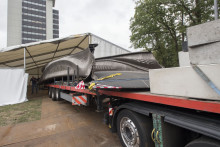‘The Bridge’, as the structure is literally called, is a 12-meter-long 3D printed stainless steel walkway. If it successfully passes all tests, the plan is to move it to the canals of Amsterdam early 2020. ‘It has been tested before, but never to full capacity. That will happen here on campus,’ says Farid Vahdatikhaki of the Department of Construction Management & Engineering and involved in the project. Researchers of Imperial College London will come to campus to test the bridge to its full loading capacity. ‘To ensure its safety and functionality, which is obviously very important to the municipality of Amsterdam as the customer,’ says Vahdatikhaki.
After the initial structural testing, the bridge will remain here for two more months, actively involving UT researchers. ‘Together with MX3D and a company called Autodesk, we will design, develop and test a permanent sensor network that is going to be installed on the structure.’

Digital twin
This network is going to be linked to a so-called digital twin. ‘This is a living computer model. The performance of the physical bridge can be tested against its digital twin,’ explains Vahdatikhaki. ‘This should help predict when the structure needs maintenance and the data will provide valuable insights for future 3D printed structures.’
The UT researcher says he’s very excited about having the 3D printed steel bridge on campus. ‘The UT has already been involved in the project. Now we get the opportunity to add more value to it. To me, the most interesting part is that the design is a close collaboration between human and computer. For the field of civil engineering, that is a rather new and exciting development.’
Any people who want to walk the bridge themselves will have to wait, says Vahdatikhaki. ‘The exact details are yet to be discussed. But it will probably be open at the end of October.’








